A Post-Midnight Moon and Pre-dawn Planets, Brilliant Venus Heads Home, Mars Flees the Bees, and Glancing at Globulars!

This image of Messier 13 in Hercules, the father of all globular star clusters visible from the Northern Hemisphere, was captured by Martin Pugh. Hundreds of thousands of stars, 25,000 light-years away from the sun, are arranged in a sphere by their mutual gravitational attraction. M13 is visible as a faint fuzzy patch to the unaided eyes on a moonless night, and through binoculars and backyard telescopes, even from the city. NASA APOD for June 14, 2012
Hello, June Stargazers!
Here are your Astronomy Skylights for the week of June 4th, 2023 by Chris Vaughan. Feel free to pass this along to your friends and send me your comments, questions, and suggested topics. You can also follow me on Twitter as @astrogeoguy! Unless otherwise noted, all times are expressed in Eastern Time. To subscribe to these emails please click this MailChimp link.
If you’d like me to bring my Digital Starlab portable inflatable planetarium to your school or other daytime or evening event, or deliver a session online, contact me through AstroGeo.ca, and we’ll tour the Universe, or the Earth’s interior, together! My terrific book with John A. Read entitled 110 Things to See With a Telescope is a guide to viewing the deep sky objects in the Messier List – for both beginners and seasoned astronomers. DM me to order a signed copy!
The moon will wane and rise later this week, so it will mainly be visible from the wee hours and into the early morning daylight. I share some information about globular clusters, which are great to view when there’s no moon around. In Evening, Venus sparkles near the twins after sunset and Mars will pull away from the Beehive Cluster. The bright planets Saturn and Jupiter will shine before sunrise. Read on for your Skylights!
A Glance at Globular Clusters
Globular star clusters are among the easiest to see of the deep sky objects. They don’t require a big telescope and you can see them telescopically from the partially light-polluted sky of your driveway or backyard. Some of the bright ones are even visible in binoculars in a dark sky.
During June, the best globular star clusters to see from mid-northern latitudes start to become well-placed in the evening sky. In binoculars they’ll appear as a fuzzy, grey star. In a backyard telescope, they resemble sugar or salt spilled on a black velvet cloth. Here is some information about them. Below, I’ll point you to some of the best on June evenings! Last year, I talked in detail about globular clusters on my Insider’s Guide to the Galaxy webcast. The YouTube link to it is at https://www.youtube.com/watch?v=LTMuEXb0pM0.
Globular star clusters, or globulars, for short, are densely packed, spherical concentrations of very old stars that are held together by their mutual gravitational attraction. Each cluster orbits its galaxy’s core like bees buzzing around the hive. At present, we know of about 160 globular clusters around our home galaxy – but 10-20 more are likely to be hidden behind the Milky Way in the sky. We have also found many globular clusters around other galaxies. Some of the ones around the Andromeda Galaxy can be seen in very large telescopes and in long-exposure photographs!
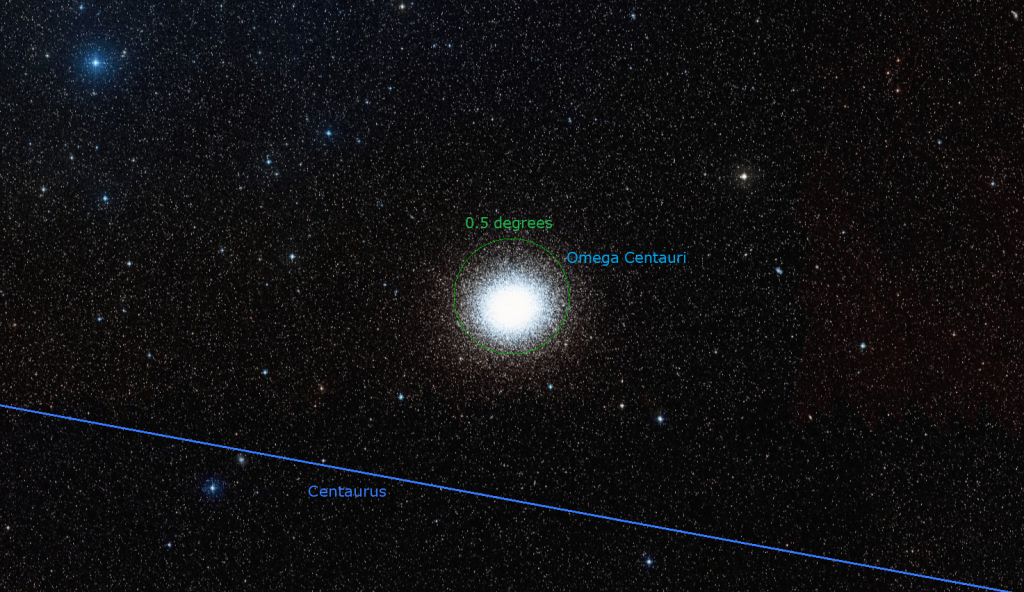
A huge and bright globular cluster named Omega Centauri has appeared as a fuzzy star to unaided human eyes since antiquity. It is only visible on Earth south of about 30° N latitude, so if you ever have a chance to visit South America, Africa, or Australia / New Zealand, look for it!
After telescopes became available in the mid-17th century, astronomers like Edmund Halley, Nicolas Louis de Lacaille, Charles Messier, and others used them to explore the sky. Comet-hunting was especially popular since new ones were named for you and other natural scientists lauded your achievement. Observers frequently came across faint, fuzzy objects in the sky that could easily be mistaken for a true comet, so they began to describe and publish lists of them in scientific journals. (Comets move from one night to the next, while deep sky objects are fixed with respect to the surrounding stars.)
By the late 18th century, the comet-hunters had found and recorded 34 of what we now know as globular clusters. They called them nebulae since they were unable to resolve their stars with their small and limited quality telescopes. From 1782 to 1802, the astronomer William Herschel, using 6”, 12” and 18” aperture telescopes, systematically searched the sky for every deep sky object he could find. He added 36 more globular clusters and was able to resolve them into stars, leading him to coin the term “globular star cluster”.
Canada’s Helen Sawyer Hogg, under American astronomer Harlow Shapley while at Harvard Observatory, started studying the use of variable stars in globular clusters as distance measures. She later immigrated to Canada’s Dominion Astrophysical Observatory in Victoria and completed her storied career at the David Dunlap Observatory in Richmond Hill, Ontario. In 1947 she published a list of 99 Milky Way globulars – but only 97 were genuine. In 1959, she expanded the list to 118, of which 115 were genuine. In the decades since the list has grown to ~160.
While their formation is not entirely understood, we know that globular clusters are truly ancient – perhaps 12.7 billion years old. (The Big Bang occurred 13.8 billion years ago.) Spectral analysis shows that their stars are old enough to have formed early in the history of the universe, when there was far less of the heavier elements being incorporated into stars now, such as helium, lithium, and carbon. Astronomers call those stars Population II or low metallicity stars. Unlike galaxies, the stars in globular clusters all tend to be about the same age. The Milky Way has two separate groups of clusters, each with differing ages and located in somewhat different parts of our galaxy. Astronomers suspect that the older group formed along with the Milky Way while the second set may have been extracted when the Milky Way merged with another galaxy.
There are typically hundreds of thousands of stars in a globular cluster – all packed into a volume of space between 100 and 300 light-years in diameter. That translates to an average star spacing of 1 light-year – and only 0.3 light-years in their core. In comparison, the nearest star to our sun is about 4.5 light-years away. The night sky of a planet inside a globular star cluster would be a tapestry of brilliant diamonds. It would never get dark with so many distant suns in the sky. Two-way communication between star systems would happen in months, not decades or centuries!
Unfortunately, the metal-poor chemistry of globular clusters means that no terrestrial planets would form. There could be brown dwarf or super-Jupiter objects made from hydrogen, but they would frequently encounter a star and be subject to tidal disruption and/or ejection from the cluster. Maybe the James Webb Space Telescope will find planets in globular star clusters!
In space, collections of matter tend to collapse inwards under gravity – but globular star clusters remain “fuzzy” due to the abundance of binary star pairs in their interior. With so many dance partners bogeying vigorously (i.e., orbiting one another rapidly), any star that tries to fall inward gets pushed back to the edge of the dance floor or “cuts in”, forming a new pairing. Binary star systems therefore act like springs – storing and releasing gravikinetic energy. Their “heat” energy keeps the core of the globular cluster inflated against the push of gravity, like the stellar static equilibrium that keeps stars shining. Interestingly, some stars in globulars do get squeezed together and merge to become anomalously bright blue straggler stars.
Many of our globular clusters orbit at distances smaller than the radius of the plane of our disk-shaped Milky Way galaxy. That means they can plunge through the galactic plane every hundred million years or so, absorbing interstellar gas and dust. Such passages can also give globular clusters trailing streams of stars that we can see in a backyard telescope.
In the sky, most globular star clusters surround the centre of the Milky Way, which sits near the teapot-shaped stars of Sagittarius (the Archer). In early June those stars rise at about 10 pm local time – but they’ll appear half an hour earlier with each passing week. 90% of the clusters are positioned within 90 degrees of the galactic centre. Two exceptions are the Intergalactic Wanderer (NGC 2419) in Lynx, which is 154° from the centre, and Messier 79 (NGC 1904) in Lepus (the Rabbit), which sits 124° away in the winter sky. Those strangely positioned ones may be captives from absorbed dwarf galaxies.
In short, Sagittarius (the Archer) contains about 40 globular star clusters, Ophiuchus (the Serpent-Bearer) has 37 of them, and Scorpius (the Scorpion) has 30, making summer the season to see globulars!

Before I point out some of the best ones for you to look at, I should mention how they differ from one another, making it worthwhile to view more than one. The clusters that are closer to us tend to be brighter and larger in binoculars and telescopes. Some that should be bright have been diminished or extincted by the dust or gas of the Milky Way lying between them and us. Aside from that, astronomers have discovered that the clusters can vary widely in their density or compactness – perhaps due to pulsations that cause them to swell and contract at various times, or by the collapse (temporarily or permanently) of their cores. (Did the dancers get tired?)
From 1927 to 1929 Harlow Shapley and Helen Sawyer-Hogg created 12 classifications to describe the degree of concentration. Interestingly, the most dense Class I cluster Messier 75 (NGC 6864) and the least dense Class XII cluster the Summer Rose Star Cluster aka Messier 55 (NGC 6809) are near to one another in eastern Sagittarius. They’ll be best seen in mid-August.
This week after the sky darkens, face southwest and seek out 7.7 magnitude globular Messier 53 (or M53) in Coma Berenices (Berenice’s Hair). It’s just to the upper left of the medium-bright star Diadem. A larger and brighter globular cluster named Messier 3 is located in Canes Venatici (the Hunting Dogs), a generous fist’s diameter to the upper right of the very bright star Arcturus.
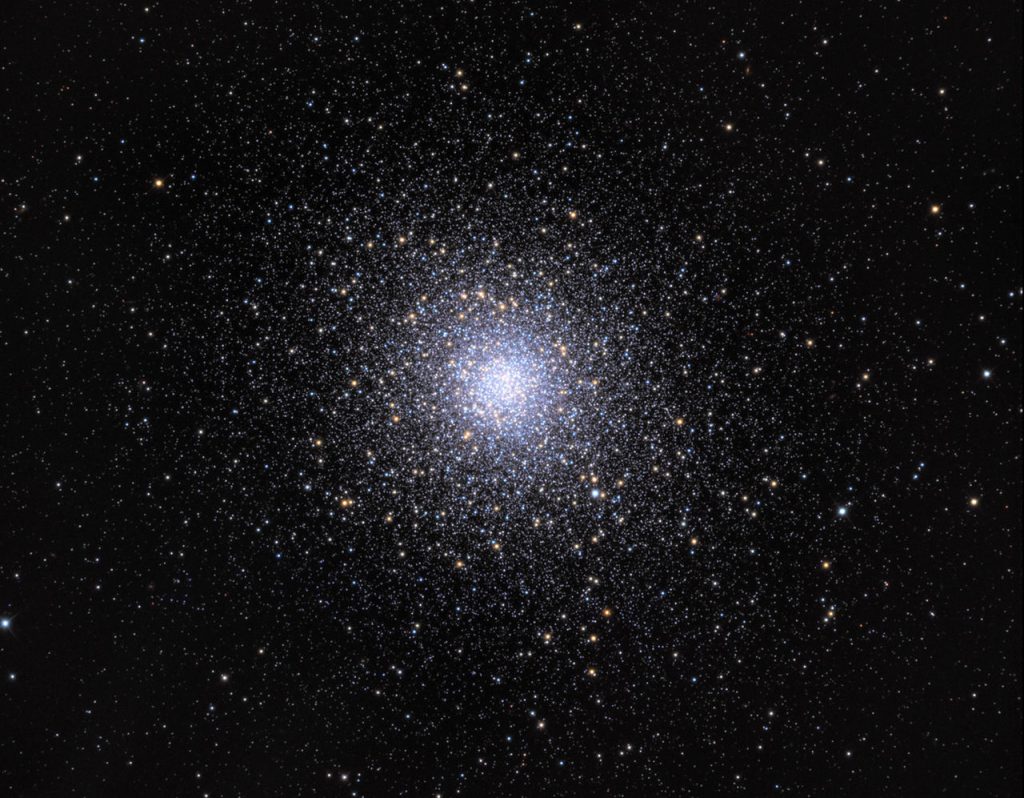
A third bright, magnitude 6.5 cluster named the Rose Cluster or Messier 5 lies in Serpens Caput (the Snake’s Head), 2.3 fist diameters to the lower left (or 23° to the celestial southeast of) Arcturus. It is approximately 24,500 light-years away from us.
Facing east, the constellation of Hercules will be situated between the very bright stars Arcturus and Vega. It hosts two terrific globulars. Messier 92 shines at magnitude 6.5. The brightest globular for mid-latitude observers – the Great Hercules Cluster, aka Messier 13 gleams at magnitude 5.8.
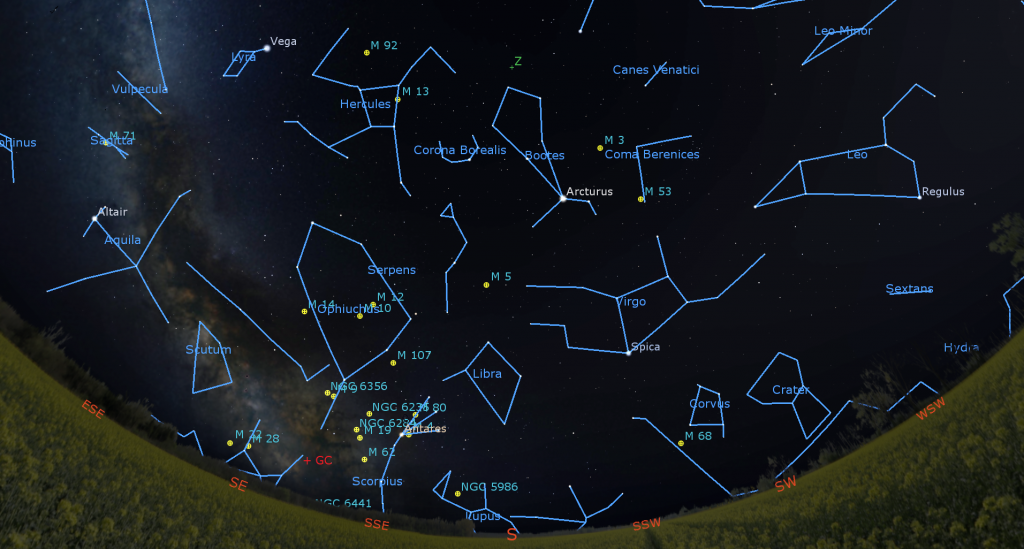
The many globular clusters that populate Ophiuchus (the Serpent-Bearer) and Scorpius (the Scorpion) will be at their best after midnight – but they’ll take centre stage in a few weeks.
The Moon
After a couple of weeks devoted to moon viewing, the world will return to moonless evening skies this week – perfect for seeing June’s celestial showpieces. Since the moon was full on Saturday evening in the Americas, it will spend the coming week waning in phase and rising more than an hour later each night for observers at mid-northern latitudes.
Tonight (Sunday) the still very full-looking moon will rise with the stars of western Sagittarius (the Archer) shortly after 10 pm in your local time zone. While you won’t see the Milky Way, the moon will be located very close to the spot in the sky where the centre of our home galaxy is. The moon will spend Monday and Tuesday night crossing the Archer’s stars.
Starting on Tuesday the moon will shine with stars between midnight and dawn, and then it will remain in view alone in the lower part of the south and western daylit sky. The moon will swim through Capricornus (the Sea-Goat) from Wednesday to Thursday.
When the half-illuminated moon rises in the east during the wee hours of Friday morning, it will be shining a fist’s diameter to the right (or 10 degrees to the celestial southwest) of yellowish Saturn’s bright dot. The pair will remain visible until the sky brightens ahead of sunrise – then Saturn will fade from view. On Saturday morning, the easterly orbital motion of the moon will have carried it to Saturn’s lower left – now close enough for them to share the view in binoculars. Either morning will make a nice photo opportunity.
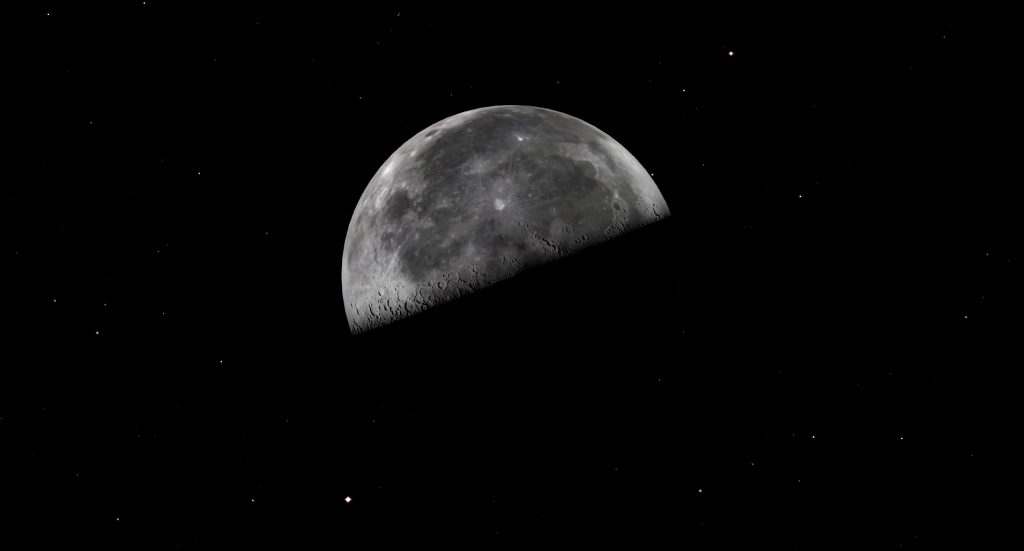
The moon will officially reach its third quarter phase at 3:31 pm EDT, 12:31 pm PDT, or 19:31 Greenwich Mean Time on Saturday. At third (or last) quarter the moon appears exactly half-illuminated, on its western, sunward side. At mid-northern latitudes the third quarter moon will rise around 1:45 am local time and then remain visible until it sets in the western daytime sky in early afternoon. The week of dark, moonless evening skies that follow this phase are the best ones for observing deep sky targets.
On Sunday morning, the waning crescent moon will be positioned on the border between Aquarius (the Water-Bearer) and Pisces (the Fishes). If you have a clear view of the southeastern horizon before sunrise, you can see the moon shining prettily between Saturn and Jupiter.
The Planets
The morning sky is busy! Three bright planets, two fainter ones, and an asteroid are all strung along the ecliptic in the pre-dawn sky.
The bright, creamy-coloured dot of Saturn will clear the trees in the southeast after about 2:30 am local time. For 2023 (and during 2024) the fainter stars of Aquarius (the Water-Bearer) will surround Saturn – but they’re not very brilliant. The early June sunrises mean that the ringed planet will still be climbing when the southeastern sky starts to brighten after 4:30 am. You’ll lose sight of the planet altogether around 5 am. Saturn will start rising before midnight at the end of June, and then it’ll be available for evening enjoyment during summer and into mid-winter! Don’t forget to spot the pretty waning gibbous moon posing with Saturn before dawn on Friday and Saturday!
The planet Neptune, which is located in western Pisces (the fishes), is positioned two fist diameters to Saturn’s lower left (or 20° to the celestial east). The distant blue planet is 600 times fainter than Saturn and too low in the sky for decent views yet. It’ll officially join the evening sky around mid-July, so we’ll get to see Neptune in backyard telescopes from August onwards.
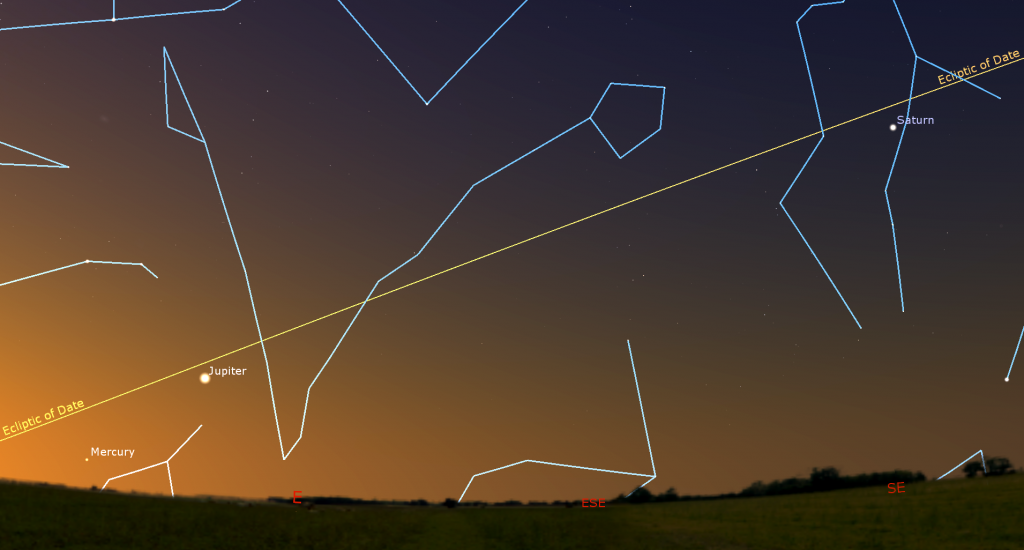
The giant planet Jupiter, which shines about 16 times brighter than Saturn, will rise around 3:30 am and will clear the eastern rooftops as the sky starts to brighten around 4:30 am. If you have an open and cloud-free eastern horizon you’ll be able to see Jupiter’s gleaming white dot until almost sunrise. The tilt of the morning ecliptic will keep Jupiter relatively low in the sky for a while yet. In a few weeks, though, Jupiter will rise early enough to shine in a dark sky amid the stars of its host constellation, Aries (the Ram). Jupiter will start to rise before midnight by the second week of August, and we’ll be able to view it from then until March, 2024.
From time to time, observers with good quality telescopes can watch the small, round, black shadows of the four Galilean moons travel across Jupiter’s disk. On Thursday morning, June 8, observers at longitudes near eastern Australia and Papua New Guinea can see two shadows cross the southern hemisphere of Jupiter simultaneously. At 4:30 am Australian Eastern standard Time (or 18:30 GMT on June 7), the shadow of Europa will join the shadow of Io, which began its own crossing of the planet 50 minutes earlier. Io’s shadow will leave Jupiter at 5:45 am AEST, and Europa’s will complete its own trip about an hour later.
Another especially fine double shadow crossing event on Jupiter will occur on Sunday morning, June 11. Observers with good telescopes in eastern North America and all of South America can watch the shadows of Io and Europa cross the southern hemisphere of Jupiter along with the Great Red Spot! At 2:35 am EDT or 06:35 GMT, the shadow of Io will begin its crossing. The Great Red Spot will start to rotate into view about half an hour later, followed by Europa’s shadow at 3:52 am EDT (or 07:52 GMT). In some locales the sky will be brightening when Io’s shadow leaves Jupiter at 4:42 am EDT (or 08:42 GMT).
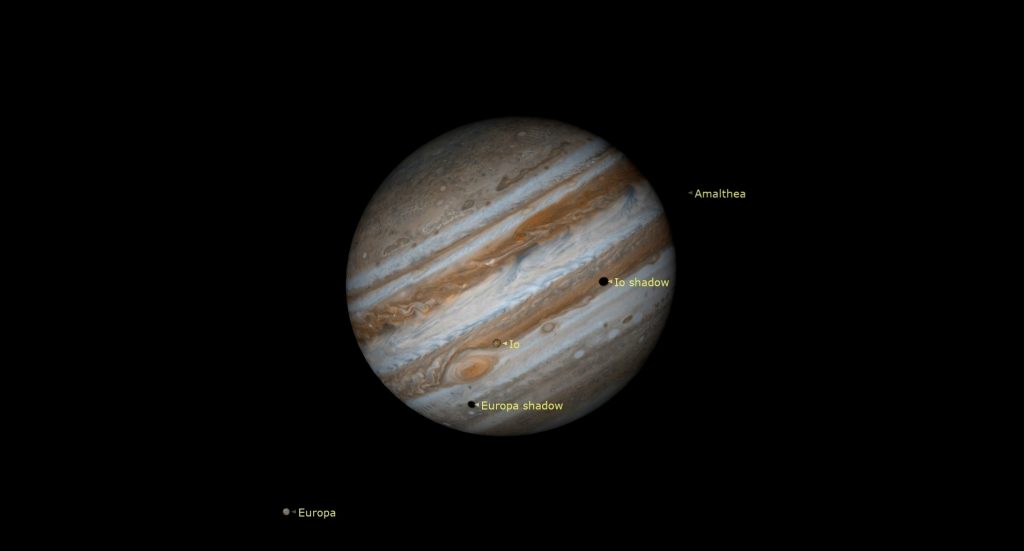
The planet Mercury is also in the pre-dawn sky. If you have a cloud-free, unobstructed eastern horizon, look just before sunrise for Mercury’s medium-bright dot positioned about 1.7 fist diameters to Jupiter’s lower left (or 17° to the celestial east). The best time to search at mid-northern latitudes will be about 5 am local time, but turn your binoculars away before the sun rises. Observers in the tropics will see Mercury much more easily. Don’t fret if you miss this appearance. Mercury will put on a great show for us in September.
From now until Thursday, Mercury will be passing close enough to Uranus to allow them to share the view in binoculars. Unfortunately for observers along mid-northern latitudes, the pair will be hugging the horizon and bathed in pre-dawn twilight. The two planets will be easier to see if you live in the southern USA or farther south, where they’ll shine in a dark sky for a while before dawn. On Monday morning, 200 times fainter Uranus will be positioned several finger widths above (or 2.5° to the celestial north-northwest) of Mercury. Be sure to turn all optical aids away from the east before the sun rises. Observers at those southerly latitudes might also spy the faint, 8th magnitude speck of the main belt asteroid designated (4) Vesta. It will be located two finger widths below (or southeast of) Mercury. If you are located where you can safely view Mercury in a telescope, you’ll see that it is only half-illuminated.
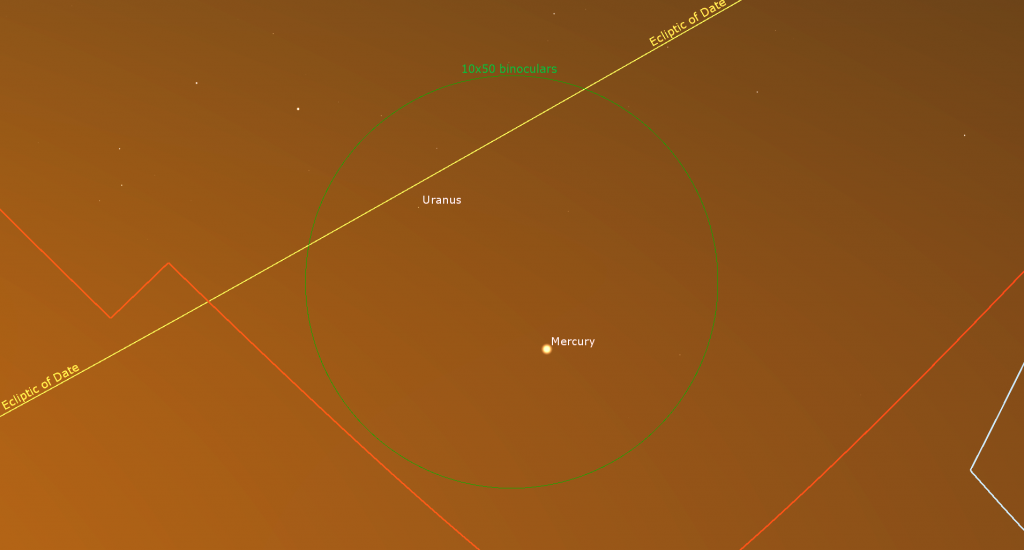
The evening sky is still dominated by the brilliant “Evening Star” Venus. That planet will first pop into view about one-third of the way up the western sky as the sun is setting. Then it will descend and set around midnight in your local time zone. Once the sky darkens some more, look for the two bright stars of Gemini, white Castor and golden Pollux twinkling to the right of Venus. Due to Earth’s orbital motion all the stars in the west drop a little lower and sunward each night, causing Venus to appear to shift “higher” compared to them. But that’s illusory. Last week, Venus reached the outer turn of its orbit around the sun. From now on the planet will drop a little lower in the sky when viewed at the same time each evening. We’ll lose sight of it altogether during July.
Viewed in a telescope this week, Venus will display a half-illuminated disk that is waning daily. To see the planet’s shape most clearly, wait until the sun has fully set and then aim your telescope at Venus while the sky is still bright. That way Venus will be higher, shining through less intervening air, and her glare will be lessened. Even good binoculars can hint at Venus’ non-round shape.
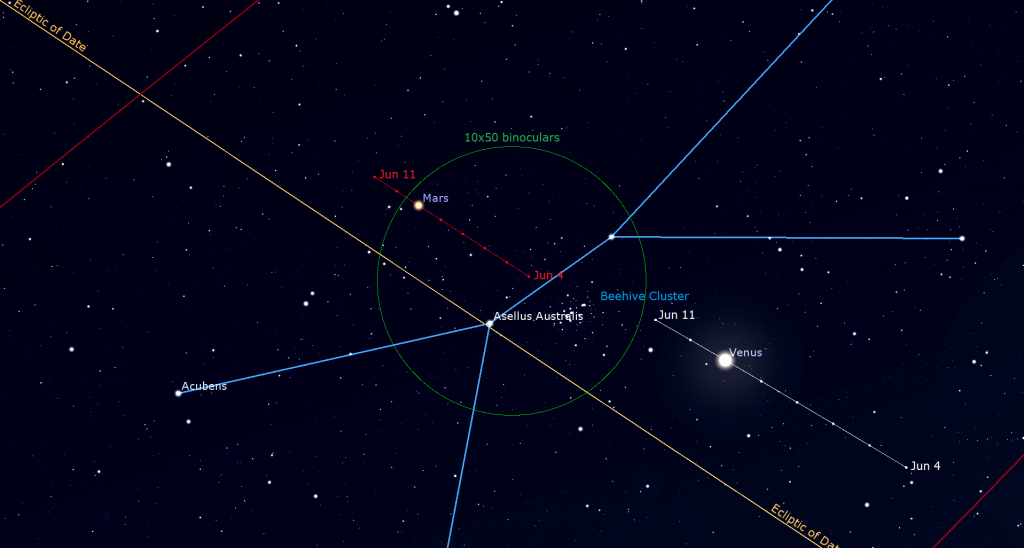
After the sky has darkened this week, the reddish dot of Mars will appear in the west a generous palm’s width to the upper left (or 8° to the celestial east) of Venus. Like Venus, Mars will look best in a telescope while it is highest, right after dusk, but its ruddy disk will look tiny under any magnification. Mars will set at about 12:30 am local time. Last week I described Mars’ trip directly through the large open star cluster in Cancer known as the Beehive, Praesepe, and Messier 44. From tonight onwards, Mars will head away from the cluster, but you can still catch their pairing in binoculars for most of this week, especially now that the bright moon will be gone. Let me know if you got a photograph of the main event on Friday night.
Venus will make its own visit with the bees next week and move closer to Mars through the month.
During March of this year the minor planet designated (1) Ceres, the largest object in the main asteroid belt, passed close to several bright galaxies while it travelled through the Virgo Cluster of Galaxies – setting up some nice photo opportunities. Now that Ceres has completed its westerly retrograde loop, it is travelling east again – although below (south of) the main cluster. Nevertheless, the magnitude 8.2 object, which is visible in full-sized binoculars and backyard telescopes, will pass close to some galaxies in the next several weeks. As this week progresses, telescope-owners can watch the minor planet approaching the spiral galaxy NGC 4124. They’ll be closest together next Sunday and Monday. You can use the very bright star Denebola, which marks Leo’s tail, and less-bright Omicron Virginis, to guide you.

Public Astronomy-Themed Events
Every Monday evening, York University’s Allan I. Carswell Observatory runs an online star party – broadcasting views from four telescopes/cameras, answering viewer questions, and taking requests! Details are here. They host in-person viewing on the first clear Wednesday night each month. Other Wednesdays they stream views online via the observatory YouTube channel. Details are here.
On Wednesday evening, June 7 at 7:30 pm EDT, the RASC Toronto Centre will host their free, public, in-person monthly Recreational Astronomy Night Meeting in the Gemini East Room at the Ontario Science Centre. The meeting will also be live streamed at https://www.youtube.com/rasctoronto/live. Talks include The Sky This Month presented by me, the North-East Astronomy Forum (NEAF), and analysis of NASA’s DART asteroid re-direct Mission. Details are here.
My free, family-friendly Insider’s Guide to the Galaxy webcast with RASC National returns on Tuesday, June 6 at 3:30 pm EST. Charles Ennis will talk about “Eyes in the Skies”, celestial objects named for eyes. Then I (Chris Vaughan) will highlight our next batch of spring RASC Finest NGC objects. You can find more details and the schedule of future sessions here.
Space Station Flyovers
The ISS (or International Space Station) will not be visible gliding silently over the Greater Toronto Area this week.
Keep looking up, and enjoy the sky when you do. I love questions and requests. Send me some!